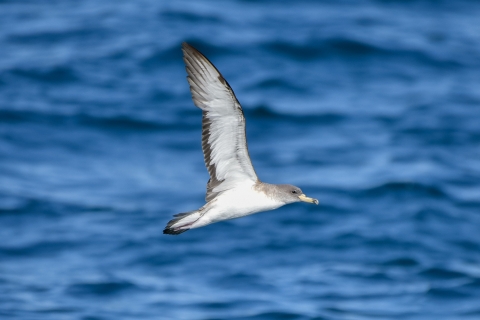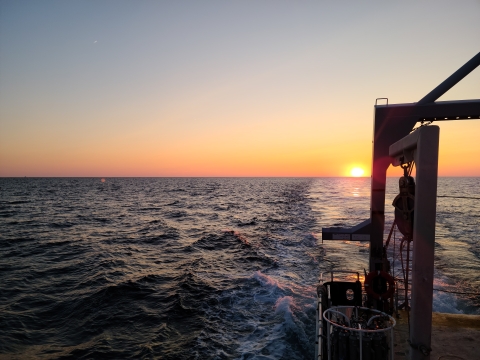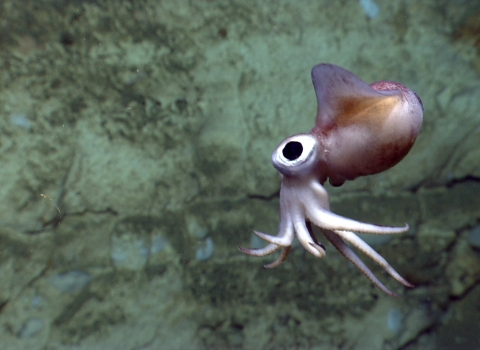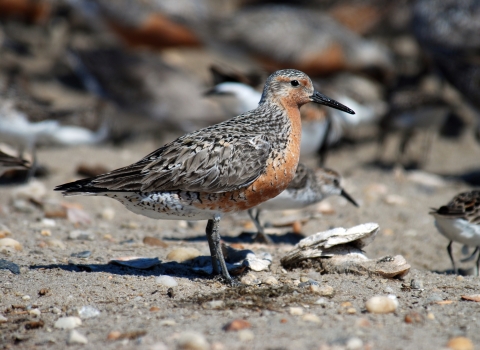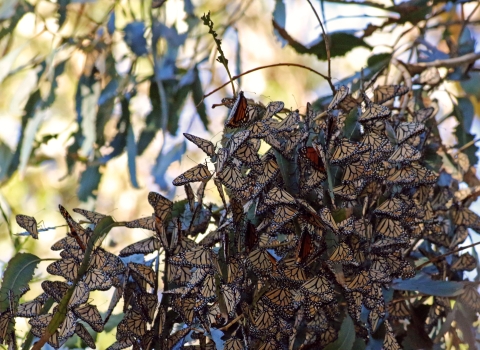At the peak of New England summer, they took to the sea.
The explorers: U.S. Fish and Wildlife Service staff Meta Miner and Mael Glon, joining a small team of passionate research scientists
Their destination: the Northeast Canyons and Seamounts Marine National Monument, a protected oasis of marine life 130 miles off the coast of Cape Cod
Their mission: to boldly go where few birders have gone before
This research expedition to the monument — the first of its kind for the Service, made possible through a cooperative agreement with the National Oceanic and Atmospheric Administration and Mystic Aquarium — marked a new chapter in our quest to better understand and protect this extraordinary hotspot of biodiversity in the Atlantic Ocean.
Ocean wilderness
Established in 2016 by presidential proclamation and co-managed by the Service and NOAA, the Northeast Canyons and Seamounts Marine National Monument is a brilliant, vast area of open ocean larger than Yellowstone National Park. Below the surface, magnificent geological formations — submarine canyons and mountains, or seamounts — cover the landscape and support a plethora of marine life.
The monument is a marine scientist’s dream laboratory; its protected status and pristine conditions allow researchers to study ocean ecosystems in the absence of human activity.
When Meta Miner — assistant refuge supervisor with the Service’s Northeast Region who currently leads Service efforts with the monument — got the call to join a research expedition and survey seabirds, she couldn’t resist.
“I’ve led a wide variety of bird surveys throughout my career with the Service, but this was an entirely different type of field experience that really excited me,” Miner said.
Seabirds are major players in marine ecosystems, serving as indicator species of ecosystem health. Studying seabirds — where they live, where they go and what they need to survive — gives scientists a better understanding of how to protect them and their habitats.
Seabirds can be tough to study for us land-based creatures, however, and research expeditions are few and far between. That made this expedition to the monument a big deal.
Needing a partner, Miner recruited Mael Glon, supervisory data manager for the Northeast Region’s Refuges program, having detected his pelagic passion from a photo of a puffin on his desk.
The two joined a diverse crew of interdisciplinary scientists from partner agencies, including Dr. Yuan Liu of NOAA Fisheries, who sought to collect environmental DNA to analyze biodiversity in the monument, and Dr. Mary Beth Decker from Yale University, who would tow a plankton camera and collect and identify gelatinous animals.
Dr. Peter Auster, senior research scientist at Mystic Aquarium and research professor emeritus at the University of Connecticut, led the team. He was on scuba duty — set to deploy baited remote underwater video cameras to study apex predators.
A longtime advocate for the monument’s protection, Dr. Auster carries the breezy charm you’d expect of a man who has spent most of his life immersed in the wonders of the sea.
“The monument is an ocean wilderness,” he said in a press release. “It’s an extraordinary opportunity to study how wild animals live and interact in a relatively undisturbed environment.”
I saw a bird today, oh boy
A day in the life surveying seabirds offshore can be boiled down to three main steps:
Step 1: Wake up at 5:30 a.m., grab coffee and immediately head for the deck.
Step 2: Stare at the ocean for the next 13+ hours counting birds. Lots and lots of birds.
Step 3: Eat and sleep. Repeat.
Sprinkle in stormy weather (more on that later), shoebox-sized crew quarters and a generous dash of sleep deprivation, and what you get is a tough gig. But for two self-proclaimed bird nerds like Miner and Glon, it was a thrilling, career-defining experience.
“Always having that possibility of seeing a really cool or rare bird — that definitely keeps the spirits up,” Glon said.
And cool birds they saw indeed — around 800 throughout the trip, according to their eBird trip report. Equipped with high-powered cameras and hefty zoom lenses, the duo spotted and recorded birds from sunup to sundown.
Some birds were identified and counted from two miles away. With well-trained eyes, distant specks on the horizon served up valuable data.
There were the usual suspects Miner and Glon came prepared to see — hundreds of Wilson’s storm-petrels and great shearwaters, for example. But there were surprises too, like the single red-billed tropicbird that briefly circled their boat one day.
“That was the one I was most hoping to see on this trip, so I was pretty pleased about that,” Miner said.
The biggest shock came when they saw a least bittern — a bird far more associated with coastal marshes than North Atlantic open waters.
“It was just absurd; that was the last thing we expected to see,” Glon said.
It begs the questions the Service aims to answer: What kinds of birds are here? What factors draw them here? And how can that knowledge inform future conservation efforts?
Charting a course
Research expeditions aren’t always smooth sailing, and this was no exception. Due to stormy weather forecasts and mechanical issues on the ship, the R/V Connecticut was forced to turn back early, shortening the planned 10-day voyage by several days. While Miner and Glon were able to conduct a substantial amount of bird surveying in their four days at sea, the other scientists knew they’d have to work fast to get as much as possible done in their short time within the monument’s boundary.
The apex of their voyage was a whirlwind 24 hours at the Retriever Seamount, the farthest offshore geologic formation found within the monument. Fortunately, calm waters here provided a chance for the team to work diligently around the clock before heading home.
Despite the setbacks, this expedition successfully charted a course to guide future efforts in the monument. New questions about this ecosystem have arisen from this research; now it’s a matter of going back to find the answers.
Miner and Glon have eased back into daily life since coming ashore, tending to a backlog of emails, thumbing through thousands of blurry seabird images and savoring the stable footing of the mainland. While they reflect on their remarkable journey, they’re also mindful of the bigger picture; their work is just one small piece of a big puzzle.
“There’s a fascinating story to be told here, but if this was a book, we’re only on page two ,” Glon said. “There’s so much more yet to learn about this place.”
Luckily, the wait won’t be long. Thanks to the Service’s cooperative agreement with Mystic Aquarium and NOAA, another expedition is already scheduled.
In the meantime, the focus is on sharing their experience with others.
“One of the main goals of our work is outreach to help spread the word to others about the monument,” Miner said. “We want to create that sense of wonder and care for this place, even if you never visit it.”





